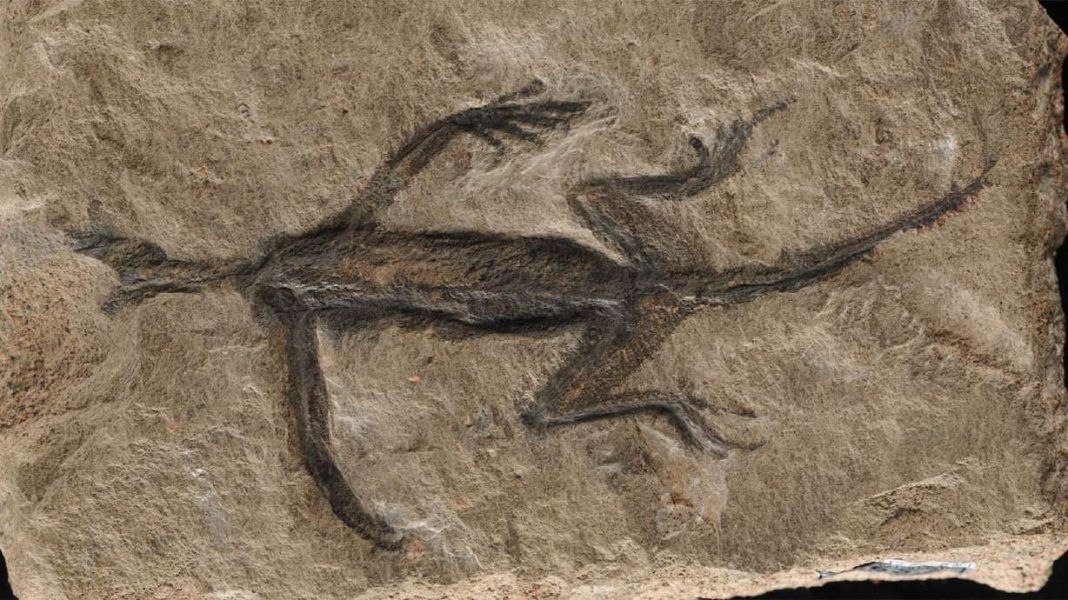ATLANTA — A fossil, believed to be a well-preserved relic of an ancient reptile dating back 280 million years, has been revealed to be largely a fabrication, as per recent research findings.
Unearthed in the Italian Alps in 1931, the fossil was given the scientific name Tridentinosaurus antiquus. The dark, distinct outline of the creature, seemingly trapped in stone, was assumed to be skin and soft tissue. This led scientists to consider the fossil as a crucial element in understanding the evolution of early reptiles.
Despite being frequently referenced in books and articles over the years, the fossil had never been subjected to a detailed study. Stored in the collections of the University of Padua’s Museum of Nature and Humankind in Italy, the artifact sparked numerous questions about the creature’s true nature, especially when no similar specimens could be located.
A recent, thorough analysis has now revealed that the fossil’s dark hue is not due to preserved genetic material, but rather black paint applied over a few bones and carved rock. The researchers who conducted the study published their findings on Feb. 15 in the journal Paleontology.
“The body outline of this fossil specimen has the same color as genuine fossilized soft tissues of plants and animals,” explained lead study author Dr. Valentina Rossi, a postdoctoral researcher in paleobiology at University College Cork in Ireland. “Without the use of diagnostic techniques, it was impossible to identify the dark-colored material correctly.”
Exposing a Fabrication
Scientists initially believed that the fossil could offer a unique insight into the evolution of reptiles.
“The fossil was considered unique because there were no other examples from the same geographical area and geological period of that preservation in a fossil vertebrate at the time,” Rossi stated.
However, certain peculiarities about the fossil, such as the absence of visible bones, including skull bones, raised eyebrows, even though the body didn’t appear entirely flat.
Intrigued by the growing doubts surrounding the fossil, Rossi and her team began their investigation in 2021 by examining it using ultraviolet photography. The analysis revealed a thick coating on the specimen, Rossi noted.
“Coating fossils with varnish is an ancient method of preservation because, in the past, there were no other suitable methods to protect fossils from natural decay,” said study coauthor Mariagabriella Fornasiero, curator of paleontology at the Museum of Nature and Humankind.
With the hope of uncovering biological information about the fossil beneath the coating, the team employed powerful microscopes to analyze the samples of the remains across different light wavelengths.
However, the researchers discovered that the body outline was carved into the rock and painted with “animal charcoal,” a commercial pigment used about a century ago, made by burning animal bones. This carving also explained why the specimen appeared to retain a lifelike shape, rather than appearing flatter like a genuine fossil.
“The answer to all our questions was right in front of us, we had to study this fossil specimen in detail to reveal its secrets — even those that perhaps we did not want to know,” Rossi admitted.
The revelation was unexpected, but it does explain why the fossil has puzzled researchers for decades.
Unraveling Old Mysteries and Unearthing New Questions
Interestingly, the fossil does contain actual bones. The hind limbs, albeit in poor condition, are real, and there are also traces of osteoderms, or scale-like structures. The researchers are now attempting to determine the exact age of these bones and the animal they belonged to. The team is also studying the rock, which may hold valuable details from 280 million years ago.
While this is not the first time a fossil forgery has been exposed, Rossi stated that this particular style of forgery is uncommon.
Due to the absence of records accompanying the fossil, including a description of what was found in 1931, Rossi and her team cannot definitively say whether the forgery was intentional.
“We believe that, since some of the bones are visible, someone tried to expose more of the skeleton, by excavating more or less where someone would expect to find the rest of the animal,” Rossi explained. “The lack of proper tools for preparing the hard rock did not help and the application of the paint in the end was perhaps a way to embellish the final work. Unfortunately, whether all of this was intentional or not, it did mislead many experts in interpreting this fossil as exceptionally preserved.”




Disagree – The findings could be a breakthrough in understanding the history of this fossil.